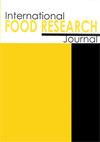微波和托盘干燥牛肉的比较研究:部分盐替代对干燥动力学和结构特征的影响
IF 0.7
4区 农林科学
Q4 FOOD SCIENCE & TECHNOLOGY
引用次数: 0
摘要
牛肉切块的干燥方法有托盘干燥(TD)、微波干燥(MD)和 TD+MD 三种。预处理时使用 NaCl 或 NaCl+KCl 盐进行盐析,以评估降钠效果。牛肉被分为九组:三组分别进行 TD、MD 和 TD+MD;其他六组使用 100% NaCl 或 50% NaCl + 50% KCl 进行干盐处理,然后进行 MD、TD 或 TD+MD。TD、MD 和 TD+MD 的处理时间分别约为 660、250 和 300 分钟,有效扩散系数(Deff)分别为 1.33 × 10-8、3.88 × 10-8 和 3.57 × 10-8 m2/s。与 TD 相比,MD 程序的质地明显更硬,复水率更低(p < 0.05)。干牛肉的扫描电子显微镜图像显示,TD 后出现了断裂和破坏,而 MD 则获得了紧凑的结构。两种类型的盐都会使再水化 MD 的质地更软,但氯化钾不会改变肉干的硬度值。通过缩短干燥时间,MD 在肉类干燥方面具有很大的潜力,氯化钾可用作氯化钠的替代品,而不会对结构质量产生不利影响。本文章由计算机程序翻译,如有差异,请以英文原文为准。
Comparative study on microwave and tray drying of beef: Effect of partial salt replacement on drying kinetics and structural characteristics
Beef cuts were dried by tray drying (TD), microwave drying (MD), and TD+MD. Salting as pre-treatment was carried out with NaCl or NaCl+KCl salts to evaluate the effect of sodium reduction. The beef was divided into nine groups: three were subjected to TD, MD, and TD+MD; for the other six groups, dry salting was applied with 100% NaCl or 50% NaCl + 50% KCl, followed by MD, TD, or TD+MD. Processing times of TD, MD, and TD+MD were about 660, 250, and 300 min, and effective diffusivities (Deff) were 1.33 × 10-8, 3.88 × 10-8, and 3.57 × 10-8 m2/s, respectively. Compared with TD, the MD procedure resulted in significantly harder texture and lower rehydration ratio (p < 0.05). SEM images of dried beef indicated fractures and disruption after TD, while a compact structure was obtained with MD. Both salt types contributed a softer texture in rehydrated MD, but KCl did not change the hardness values of dried meat. MD could have great potential for drying meat by reducing drying time, and KCl could be applied as a substitute for NaCl without adversely affecting the structural quality.
求助全文
通过发布文献求助,成功后即可免费获取论文全文。
去求助
来源期刊

international food research journal
Agricultural and Biological Sciences-Food Science
CiteScore
1.40
自引率
0.00%
发文量
75
期刊介绍:
The International Food Research Journal (IFRJ) publishes papers in English, six (6) issues a year with the coverage of:
Food Science and Technology
Nutrition and Dietetics
Agriculture, multidisciplinary
Chemistry, multidisciplinary
The scope of the Journal includes:
Food Science, Food Technology and Food Biotechnology
Product Development and Sensory Evaluation
Food Habits, Nutrition, and Health
Food Safety and Quality
Food Chemistry, Food Microbiology, Food Analysis and Testing
Food Engineering
Food Packaging
Food Waste Management
Food Entrepreneur
Food Regulatory
Post-Harvest Food Management
Food Supply Chain Management
Halal Food and Management
 求助内容:
求助内容: 应助结果提醒方式:
应助结果提醒方式:


